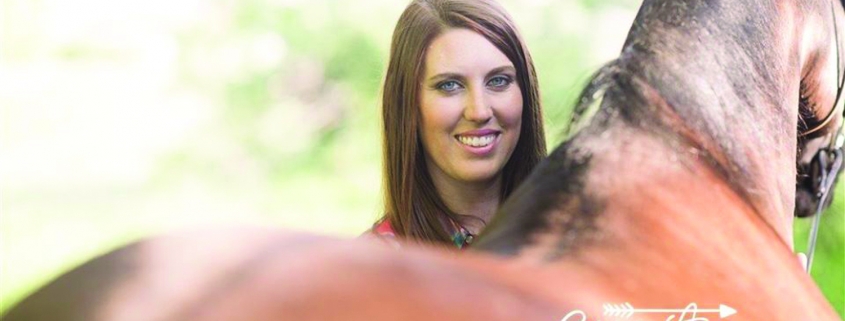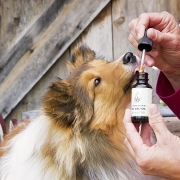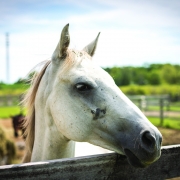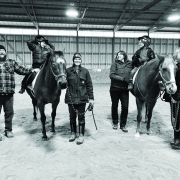Off-the-Leash with BackCountry Animal Chiropractic
Helping Spines of All Kinds
Dr. Morgan moved to Wisconsin and started her business in June 2018. She has been happily helping four-legged patients and their two-legged humans ever since. Her passion for chiropractic grew alongside her journey an obtaining her Doctorate of Chiropractic from Sherman College of Chiropractic in South Carolina, then onto Texas for postgraduate training. Today, McCaskill services “spines of all kinds,” as she likes to say and works in and around the Kiel area.
Describe Your Patients?
The majority of the patients I see are horses, dogs and humans. However, I see many other animal species for chiropractic care such as cats and cows. It is my opinion that anything with a spine can benefit from chiropractic care. My post graduate education in animal chiropractic mostly focused on horses and dogs, but I was given the tools to be able to study any animal’s spine to be able to provide them with care.
Some of my favorite patients to care for are horse and rider teams. Both see the benefit of chiropractic for their athletic performance and in their day to day lives. I cannot tell you how many times growing up riding horses that I heard “your horse is your mirror image.” When I started working with horse and rider pairs and seeing the same compensation patterns, it gave this phrase a whole new meaning to me. Horses are truly amazing in the way they adapt to our shortcomings as riders so that they can still perform their jobs, and rarely do they complain about it until it becomes a major issue. There are many riders that are now under my care for chiropractic because they would see improvement for the first few rides following adjustment, but then their horse would revert back to the same issue (such as not being able to pick up the correct lead, being grumpy when getting tacked up, head tossing, etc.). When I asked the rider the last time they had chiropractic care, they would often answer never. I will almost always find a pelvic imbalance, which can lead to uneven leg length and an unbalanced rider. After an adjustment to restore balance in the rider as well as the horse, those chiropractic adjustments start holding better and longer.
Is horse chiropractic different?
The basics of chiropractic care for horses is the same as for humans or smaller pets. The ultimate goal of chiropractic is to remove restrictions and misalignments found in the spine. Both human and animal spines house our nervous system, which consists of our brain, spinal cord, and all the nerves that branch from the spinal cord and supply the rest of the body. If there are misalignments in our spine, it results in pressure on the nervous system and a breakdown of communication in the body. We call these subluxations. Depending on where there is a dysfunction in communication, you can see different manifestations. Some common ones are fatigue, muscle weakness, decreased motion and pain. Chiropractic care addresses subluxations by using a gentle adjustment to restore the body’s ability to function optimally, communicate and heal from within.
A typical equine chiropractic appointment with me starts with an analysis of posture and gait, which tells me a lot about how the horse is functioning. Following this, I perform an assessment of the nervous system by checking certain reflexes. Then I go through every joint, checking motion and muscle tone of the surrounding tissue. Using all of this information, I know when and where to apply a chiropractic adjustment. I think it is very important to educate the owner as I adjust and show them the differences before and after an adjustment. Horses are big animals (I have some that I cannot even see over their withers without my adjusting bale!), so a typical appointment lasts 45 minutes to 1 hour. Canine chiropractic appointments have a similar flow, but they typically last about 30 minutes.
What are the benefits?
There are many wonderful benefits of chiropractic care!
Increases joint range of motion • Increases energy • Reduces inflammation
Increases circulation • Relaxes tight muscles • Reduces pain
Stimulates the nervous system, which can improve organ function
Reduces adhesions in joints
How long is recovery from an injury?
Healing is a process and varies from case to case. The same injury in one horse may take a month to recover, whereas it can take another 3 months for another. That recovery time depends a lot on the commitment and diligence of the owner to keep up with chiropractic care, at-home exercises and if we are doing other treatments in conjunction with chiropractic.
One of my patients is a 21-year-old Arabian cross Cob gelding named Monty. Monty was referred for a chiropractic evaluation by his primary veterinarian due to deficits in the function of his nervous system. Specifically, Monty was having trouble walking and did not seem to know where his feet were. His veterinarian thought he may have another underlying neurologic issue but suggested that chiropractic may help him heal and could be started while they waited for test results. At his first visit, Monty was very unstable, could barely walk and looked as though his legs were about to give out from under his body. When I performed testing on his nervous system, most of the reflexes were not present, and the ones that Monty had were not normal. I only adjusted his neck and pelvis at the first visit and let his body adapt to those changes. By his second visit one week later, the test results had come back from the vet, showing no signs of an underlying condition, so we decided the best course of action was chiropractic. Monty had his spine checked for subluxations once a week for 6 weeks. Each week we saw improvement in his posture, gait and reflexes.
The improvement was slow at first, but as time went on, we began to see more improvement at each visit. At his week 6 appointment, I saw enough improvement in Monty’s ability to hold his adjustments that we extended appointments. His gait had improved on the straightaways, though he still had difficulty with tight turns, and his reflexes were all present and normal. Monty was even doing some short trot bursts out in pasture, though his trotting was by no means a normal gait. Just before his appointment with me on week 8, Monty’s vet came back out for a check-up, and had trouble catching him because he was running around out in the pasture! Monty has stayed under chiropractic care for maintenance care. Time between appointments has increased as he has been able to hold his adjustments better—now I am seeing him every other month. His owner has also been diligent about incorporating exercises into his daily routine to help his body heal and hold adjustments. Now Monty is out in pasture playing with his pasture mate, a mini donkey named Poncho, and you would never know that 6 months ago he could hardly walk.
To find out more about chiropractic care, check out BackCountry Animal Chiropractic’s website backcountryanimalchiropractic.com or follow us on Facebook and Instagram!

